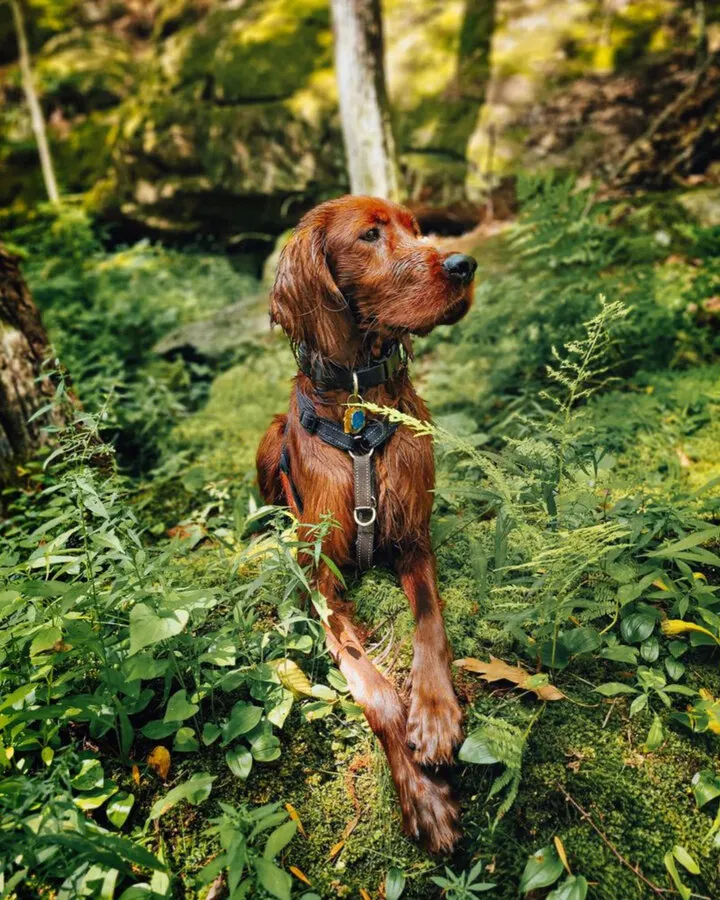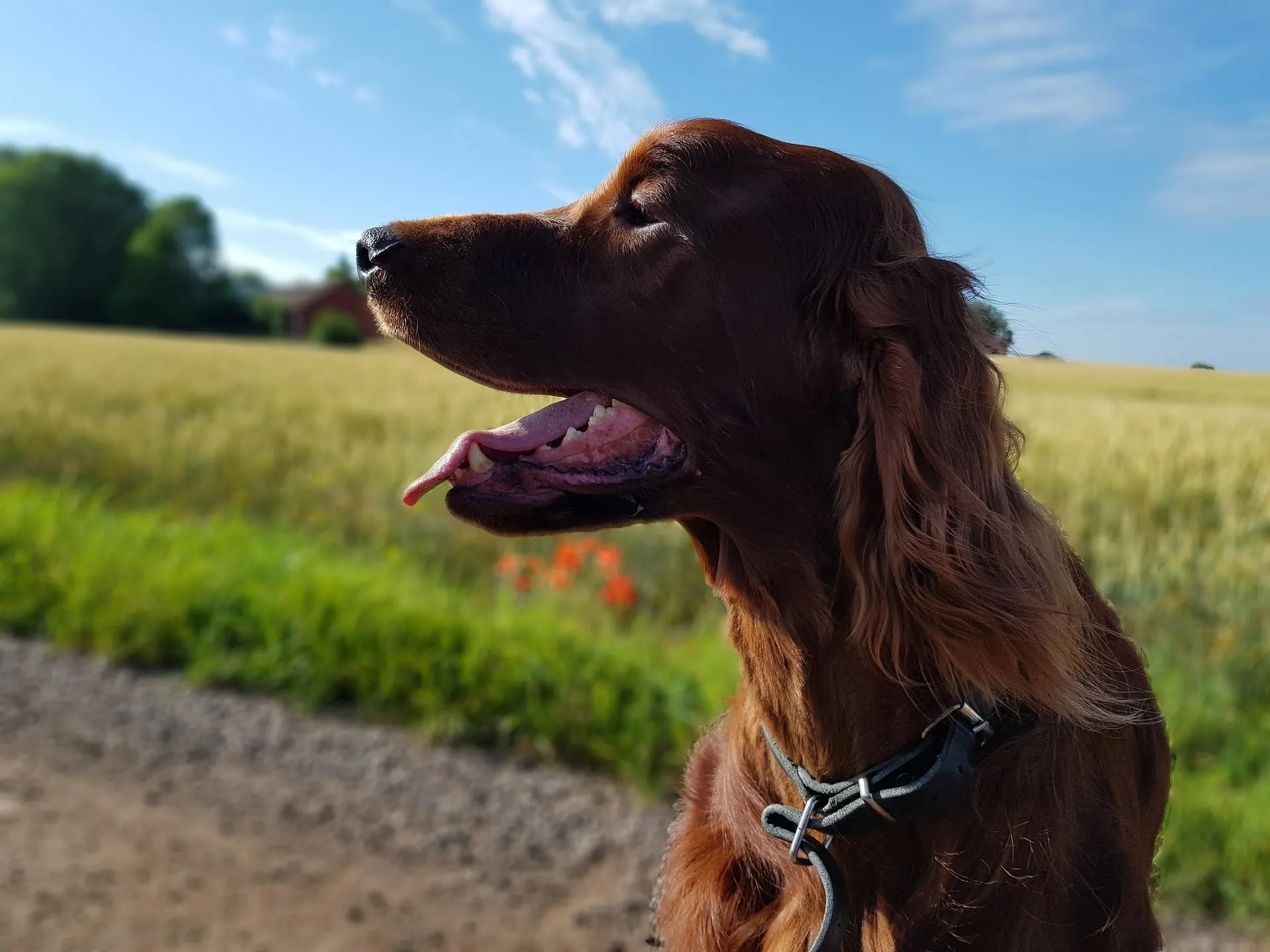Irish Settlers are one of the most popular and sought-after hunting dogs. These flame-colored beauties are also very likable as they are athletic, graceful, and full of life. When you live with an Irish Setter, you’ll always have a furry companion who is happy, friendly, and down for anything. Irish Setters were first used as gundogs in their home country of Ireland. The beauty of their rich mahogany coats and their skill as bird dogs helped the breed become popular quickly.
There are two kinds of Irish Setters: show dogs and working dogs. Irish Setter show dogs are bigger and heavier than Irish Setter field dogs, and their coats are also heavier and thicker. Both of them, however, meet the breed standard. They are great at canine sports, obedience, rally, tracking, and agility competitions, in addition to being great in the field.
The Irish Setter was originally made to hunt birds, and he still has the drive and energy of his ancestors. He loves trying new things and going to new places, especially if they have to do with birds. Even though he doesn’t hunt as often as some other sporting breeds, he still has a strong desire to do so. Once he knows how to handle birds, he never needs to be taught again.
Even though the Irish Setter loves everyone, not every home is right for him. He has a lot of energy and needs at least an hour of exercise every day. If you want to learn if this dog breed is the right choice for you, or if you should skip this canine altogether, keep reading.
History
It’s not surprising that this handsome redhead comes from Ireland, which is known for having fine and beautiful dogs. The Irish Setter probably came about when English Setters, spaniels, pointers, and Gordon Setters were mixed with each other in the 18th century.
Some of the first Irish Setters were called red spaniels, which may have been a hint about where they came from, or modder rhu, which is Gaelic for “red dog.” It’s possible that the Irish Earl of Enniskillen started the trend of all-red dogs. By 1812, he would only have that kind of dog in his kennels. Jason Hazzard of Timaskea in County Fermanagh and Sir St. George Gore were two other Irish breeders of the time who liked red dogs.
It’s hardly surprising that these dogs swiftly spread across Britain and into the United States given their startling good looks and eagerness to please temperament. The Irish Setter was one of the first nine breeds to get early American Kennel Club recognition in 1878, and in 1881 the Irish Setter Club of America was formed. The Irish setter was on its way to becoming a well-liked dog breed for hunting and companionship in the United States, alongside the English setter and Gordon setter.
They quickly became a favorite in the show ring and one of the most popular breeds in America. Between 1874 and 1948, 760 Irish Setters won competitions for their looks, but only five won competitions in the field. Some people who liked the original breed were worried about this, and wanted them to become working dogs again. Today, it’s common to see two types: the larger, heavier show dog and the lighter, sleeker field dog.

Source: Instagram (@roxy.irsk.setter)
Personality
The Irish Setter loves to have fun, plays with other dogs, and is always up for a good time. These outgoing dogs will make great family companions and won’t shy away from doing anything, and will run towards any of your family friends.
Irish Setters are friendly and enjoy being around people. They aren’t really guarding dogs, but they have helped protect their people when they had to. They are, however, excellent watchdogs and will bark when someone comes to the door or tries to get in. Irish Setters take a long time to grow up, and they often keep their puppy energy for many years, if not their whole lives.
Irish Setters are smart, but they are also independent and like to get into trouble. Training them takes a lot of time and patience. This breed takes a long time to grow up, so you’ll have a full-grown dog with puppy-like energy for a few years. Not surprisingly, they are great playmates for older, more active kids, but they can be too much for toddlers, who may get knocked down by this mischievous redhead.
Always remember that these are hunting dogs, bred to run hard all day on rough ground. They are easy to train, but if you don’t pay attention to them, they will start running on their own and may chew, bark, or dig. Most Irish Setters are friendly and outgoing, both with people and with other dogs. But because they are hunters, you should be careful when introducing them to smaller house pets. There are a few shy dogs in the breed, so they need to be socialized.
Caring for an Irish Setter
An Irish Setter should live in a house with a big, securely enclosed yard or some land. This breed needs space to run. Because he is a hunting dog, it is necessary to restrict him with a fence or restrain him with a leash to keep him from getting lost. He should never live alone in a kennel or backyard; instead, he should live indoors with his family.
You should budget at least an hour of vigorous activity every day for this athletic dog in order to maintain a calm, contented demeanor. These canines enjoy brisk walks, running, and continuous tennis ball retrievals. A fenced yard is ideal for giving this breed a secure area to roam and play, but it won’t take the place of the requirement for a daily run or walk.
High-quality dog food can keep your red setter in top condition. A protein-rich diet that offers lots of energy for daily romps in the dog park or outdoor activities would suit this energetic breed well.
The Irish Setter should not be let to consume food too quickly because this breed is susceptible to bloat. Bloat in dogs has the potential to be fatal. Using slow-feeder dog dishes or giving smaller, more frequent meals has been successful for some people.
Training
Despite having a kind disposition, Irish Setters require active training. Like many dog breeds, this one needs to be trained consistently and with affection. If you start your setter when he or she is a puppy, be sure to give them plenty of opportunities for socialization with people and animals of all sizes. The Setter’s prey drive can occasionally be triggered by smaller domestic pets because they were bred to flush game. With appropriate, regular training, this propensity may typically be modified and restrained.
Irish Setters are smart, trainable dogs, but you must be stern and consistent with them if you don’t want them to take advantage of you. You need to be able to lead without getting angry or employing force. The main goal of training an Irish Setter is to keep him from getting bored. Use tactics for positive reinforcement, such as food prizes, praise, and play, and stay away from monotonous workouts. To keep his interest, often switch prizes and activities.
For your Irish Setter puppy, crate training is a need. This breed is extremely inquisitive and will inspect everything with his mouth. When you’re not around to monitor, a crate will assist keep your puppy and your belongings secure.
Irish Setters are generally simple to housebreak. Use a crate, be consistent, and keep the puppy on a schedule. The most crucial thing to keep in mind is that housetraining takes time. Although your Irish Setter puppy may be aware of where he has to relieve himself, it’s possible that he won’t have bladder control until he’s 4 months old or older. It’s critical to have someone who will let the puppy out for a bathroom break if you must be away for an extended period of time due to work or other obligations.
Exercise
Irish Setters require daily activity of at least an hour. There are several ways to accomplish this, but one of the best ways is to let the Irish Setter run. He makes a terrific running partner and will also take pleasure in running next to a bicycle. Other great methods to exercise your Irish Setter include taking long walks, playing fetch, swimming, and of course going hunting.
Puppies of Irish Setters require a distinct kind of activity. They need 15 to 20 minutes of playtime in the yard each morning and evening. From 4 to 6 months of age, daily half-mile walks, weekly obedience training, and yard playing will all take care of their needs. Play fetch with a ball or Frisbee for up to 40 minutes between the ages of 6 months and 1 year.
Your Irish Setter puppy can start jogging with you once he has reached the age of a year, but you should keep the distance to less than a mile, run on soft surfaces like grass or dirt, and give him regular pauses along the route. You can extend your runs’ duration and distance as he gets older.
Grooming the Irish Setter
One of the qualities that contribute to the Irish Setter’s status as one of the most attractive dog breeds is his gorgeous coat. The burnished mahogany or rich chestnut red coat is short and fine on the head and forelegs, medium-length and straight on the remainder of the body, and long, silky feathered on the ears and the tail.
To keep your Irish Setter’s coat lustrous and tangle-free, brush him at least once every other day. As long as you keep him well-brushed, he shouldn’t require a bath more than a few times per year. Make sure you use a special dog shampoo for this.
Ear infections are common in all breeds with pendant, or hanging, ears. Weekly inspection and cleaning of your Irish Setter’s ears with a cotton ball and cleaning solution are a must. At least twice or three times a week, brush your Irish Setter’s teeth to get rid of tartar accumulation and the bacteria that live there. This will help prevent dog dental problems.
If your dog doesn’t naturally wear down his nails, you should trim them once or twice a month. If you aren’t too sure how to do that, it’s better to ask your groomer or vet to do it for you. While grooming, keep an eye out for sores, rashes, or infection-related symptoms including redness, tenderness, or inflammation.

Health of the Irish Setter
While these sporting dogs are generally healthy, they are still prone to certain health conditions. Most of these disorders are genetic diseases. If you are buying your puppy from an irresponsible breeder, you are just increasing your risk of getting a sick dog. The most important thing you can ask for when buying a dog is health tests and genetic screenings that show your dog is as healthy as it gets.
The lifespan of these big red dogs is 12 to 14 years. However, pet owners should be aware of the following diseases that are common in this breed:
Hip dysplasia – Hip dysplasia is a growth-related malformation of the hip. In this condition, the thigh bone does not fit properly in the hip socket causing pain and loss of mobility.
Hypertrophic osteodystrophy – This condition results in lameness and is associated with dietary excesses of calcium and protein.
Progressive retinal atrophy – This is a degenerative disorder of the eye that can even cause blindness.
Canine leukocyte – This condition reduces the capacity of white blood cells to fight infections. Dogs with this condition will experience recurrent infections and immunological problems.
Conclusion
Now that you learned so much about this stunning dog and the two types that are available, you might be wondering if this is the right breed for you. Before deciding on that, you need to have a clear understanding of what the needs of this breed are.
While they do make good family dogs, there are by no means low-maintenance. They need a daily run of an hour long, and training them could also give you a hard time. These dogs are very stubborn, and you will need just as much patience to teach them what is acceptable and what isn’t.
They are the type of dog that thrives on positive training methods. They are very food motivated, so make sure you always have some snacks at hand. The best place for them to call their home would be a spacious house with a fenced backyard.
Before you buy a Setter puppy, consider calling up your local shelters. Many of these dogs are left behind by their owners and in need of adoption. But if you do want to buy, check their National Breed Club for information about reliable breeders.

